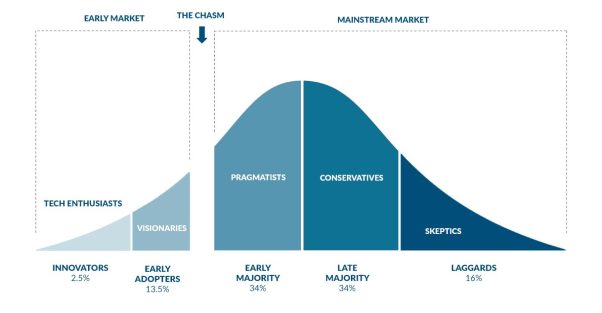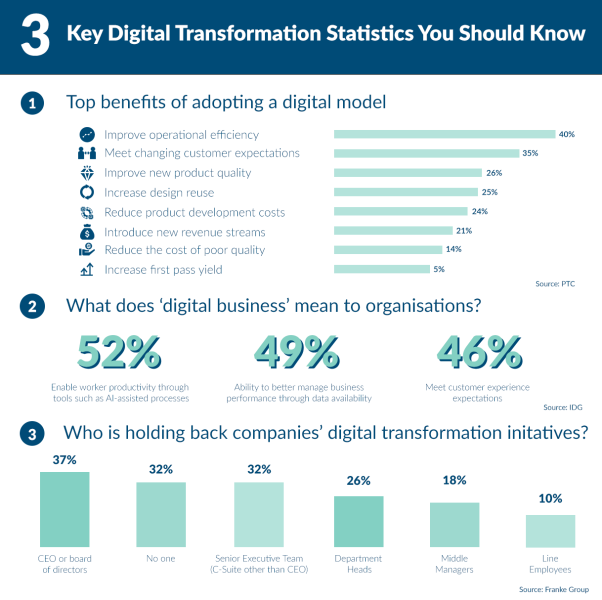When purchasing RecTech, it’s essential you know how to correctly leverage it but also educate your employees to do so too. To achieve maximum output and success, leaders must be willing to drive tech adoption instead of simply licensing new technology.
“If you get effective change in place, you’re 2x more likely to deliver in budget, 5x more likely to stay on or ahead of schedule and 6x more likely to meet objectives.”
– Caro Ruttedge, evidenced by PROSCI 2020 Benchmarking Data
Tech Adoption and Change
With the recruitment industry evolving year after year, change is the only constant in our market, but how do we ensure it’s managed, welcomed, and embraced by employees.
Did you know that according to research carried out in the industry, 70% of projects fail? That means only 30% of structural change is completed within benefit, scope, and budget.
But what are the biggest Tech Adoption challenges?
What is the Tech Adoption Lifecycle Model?
Developed in the mid-1900s, the tech adoption lifecycle best describes how customer behaviour can be broken down into various demographics: starting at Innovators and gradually moving to early adopters, early majority, late majority, and laggards.
Tech Adoption Lifecycle Model (Source)
Who are the Innovators?
Easy to get on board, Innovators are naturally excited to leverage new technologies and are significantly more open to trying out innovative tech.
Persuading the Innovators to adopt tech
These adoptees don’t need much convincing; instead, all you have to offer them is information about the product, its features, and in some cases, provide them with early access.
Who are the Early Adopters?
Despite being very adaptable to new tech, early adopters are considerably risk-orientated and can be perceived as highly demanding when it comes to the performance of your platform or tool.
Persuading the Early Adopters to adopt tech
In order to encourage adoption from early adopters, leaders must share innovator experiences, provide minimal data to back up their claims, and involve these adoptees in the early-phase rollout of the technology.
Who are the Early Majority?
Early Majority of consumers typically wait for early adopters to use, review, and positively feedback on the technology before they allow themselves to invest. These customers will only commit to a product once innovators and early adopters have assumed all of the risks and confirmed the benefits outweigh them.
Persuading the Early Majority to adopt tech
When tackling early majority adoptees, it’s essential to create rational reasoning for them to understand exactly what the technology is and how it benefits them. To do this, you must position yourself as a lasting piece of technology that’s innovative, complete with a full suite of training, resources, and space for practice.
Who are the Late Majority?
Cautious, logical, and avoiding taking risks, the late majority of consumers commonly prioritise traditional methods over progress and optimisation. Although they aren’t entirely comfortable with switching methods, they can still be convinced with good data.
Persuading the Late Majority to adopt tech
By communicating the effectiveness of your technology with supporting data, case studies, and proof from all of the other adoptees; the late majority of customers need significant convincing and training to persuade them.
Who are the Laggards?
Sceptical about new tech, reluctant to adopt new processes, and typically avoiding technology; Laggards are quick to abandon software during the learning curve if the tech isn’t immediately beneficial to them.
Persuading the Laggards to adopt tech
Despite Laggards being considerably difficult to persuade, leaders can still communicate proven performance through data, case studies, personalised stories, and relevant features they feel might benefit the consumers in the long run.
While change is a great way to improve productivity and employee engagement, it’s not always welcome, and it is easy to ignore the problem.
What you need is a change management strategy that you can implement to help the change happen and make it as easy as possible for employees to embrace.
You need to use the full range of tactics in your arsenal to promote the change and help your employees see it in a positive light.
With the adoption of tech becoming so mainstream across industries, a digital transformation is happening worldwide – especially for human-centric companies looking to scale and keep up with the moving times. The ever-changing recruitment landscape requires constant evolution, new tech adoption, and a way to beat out the competition!

So how exactly can we drive tech adoption in recruitment?
To ensure the digital transformation is entirely effective or for tech to be adopted company-wide, it’s vital to place a human-centric focus on change to ensure maximum tech adoption, enabling us to manage change with employees and success in mind.
Because of this, it’s essential to recognise that as humans, our brains simply ‘don’t like organisational change’ as explained by Hilary Scarlett in ‘The Impact of Organisational Change on the Brain.’
In fact, Scarlett even goes on to explain that our brains are wired to be distracted, anxious, fearful, and somewhat reluctant to change because of our innate biological responses; hence the effectiveness of change management strategies.
Step 1 – Engage your Team
To adopt a change management strategy effectively, you must get your team working together; this means getting them to understand the why, the who, and the how.
“The key people that will influence the success or failure of the introduction of new technology or any other kind of change is the middle management layer — the people on the ground driving new technology with users is really important.
– Steve Beckitt
You can use an understanding of these elements to help them build a shared understanding of what is changing, why and how. They can then look for how the change will help them to improve their day-to-day tasks and boost their efficiency.
Step 2 – Plan Ahead
Many people will find that a change of this magnitude can cause them to panic and resist. You need to find out where this resistance comes from, and you can use it as a way to motivate and inspire them.
You should give them a clear roadmap of where they are heading, but you also need to use this to help them overcome the initial resistance to the change and provide them with a way to adapt.
Step 3 – Accelerate the Change
The people who want to make the change will need to see the benefits, which requires you to implement the change faster. By speeding up the change, you will overcome the initial resistance, and the change will have a much greater chance of success.
Step 4 – Empower Your Team
Another effective method of driving tech adoption is empowering your staff with responsibility, giving them the flexibility and authority to manage their day-to-day tasks. They will be able to do this in a way that they are most comfortable and they can put the changes into place and operate within the new environment as needed.
When you empower your staff, you are also giving them the ability to turn to you for help, which is likely to increase the levels of engagement and productivity.
Step 5 – Teach and Develop
Although fear of the unknown often accompanies change, you must teach and develop your employees to ensure they understand the why, the who and the how so that they can support the change.
Like most change management strategies, changing the way you run your business is not a simple one-step process. There will be moments when you will find it challenging and feel overwhelmed, but that’s where your change management strategy comes in.
Planning ahead and promoting changes early increases the likelihood of a smooth-sailing transformation and successful tech adoption. Ensure you are leading the change with enthusiasm and backing from your employees; it’ll make a world of difference.
“People need to be well incentivised to adopt new technology properly rather than adding it in as a distraction to where their incentives lie.
– Steve Beckitt
For example, SourceBreaker ensures our staff are kept up-to-date with high-value training sessions and have highly-supportive success teams dedicated to facilitating the growth of our employees but also our customers–or, as we refer to them, business partners.
TL;DR Key Takeaways
- Effective change management is key to delivering projects in budget, on time, and meeting objectives.
- The biggest tech adoption challenges are the lack of managerial responsibility, organization, education, resistance to change, and reluctance to give up traditional methods.
- The tech adoption lifecycle model includes innovators, early adopters, early majority, late majority, and laggards, each with different adoption approaches.
- To persuade innovators to adopt technology, provide information about the product and its features, and offer early access.
- Early adopters require leader involvement in the early-phase rollout, sharing innovator experiences and minimal data to back up their claims.
- For early majority adoptees, it’s crucial to create a logical reasoning for them to understand the technology’s benefits and create space for practice.
- To persuade the late majority, communicate the effectiveness of technology with data, case studies, personalised stories, and relevant features.
- Laggards can be convinced by proven performance through data, case studies, and personalised stories of the benefits of the technology.
- Change management strategies should be implemented with a human-centric approach to effectively manage change and ensure maximum tech adoption.
- Engaging employees, creating awareness, communicating and providing ample training can help drive tech adoption in recruitment.
